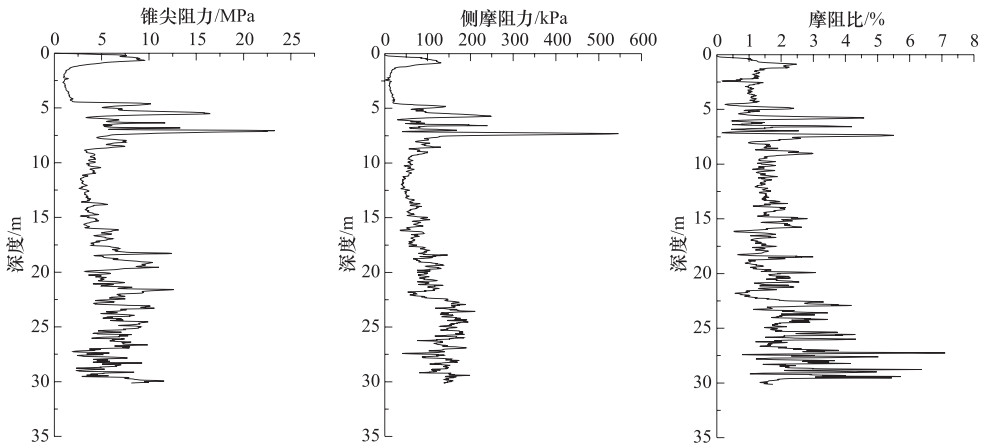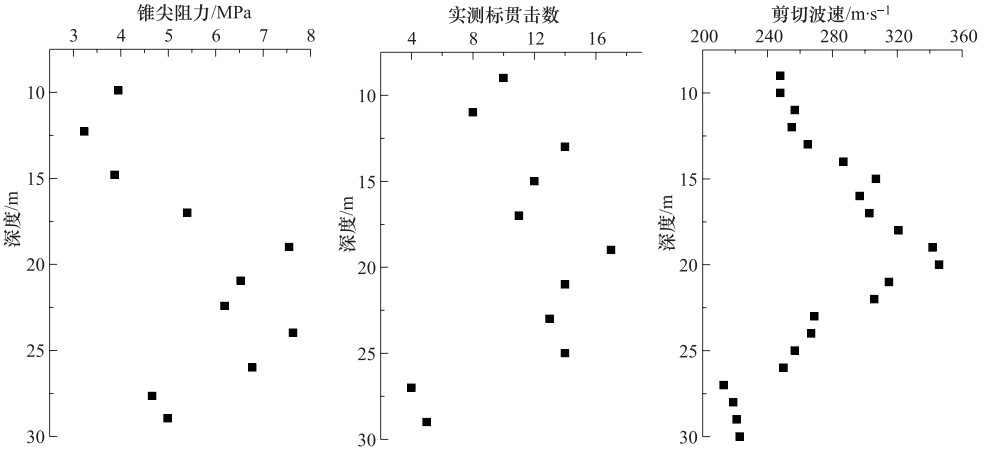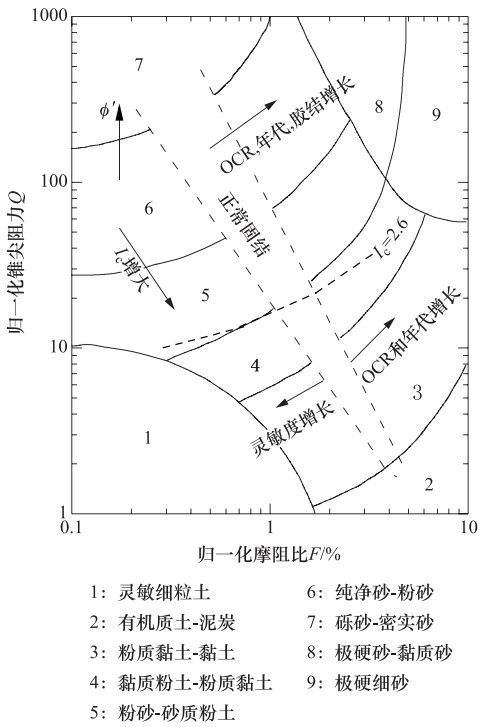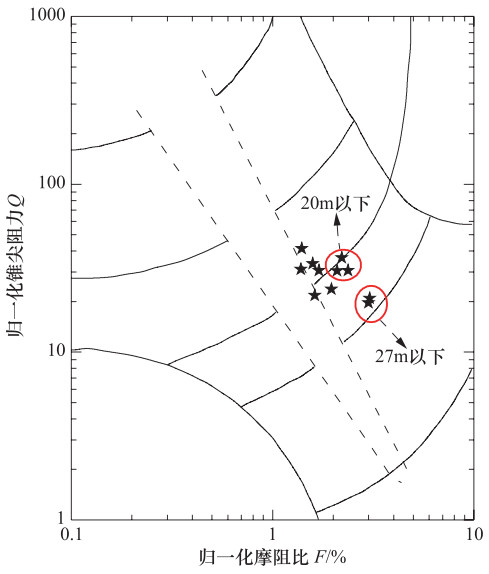In-situ Tests and Liquefaction Potential Evaluation for Saturated Loess Sites
-
摘要: 目前,主要依靠室内动力试验对黄土液化势进行评价。由于黄土特殊的结构性,室内试验对其饱和的过程较为复杂,且与实际场地饱和黄土差异明显,导致室内黄土液化试验结果并不能代表现场饱和黄土的抗液化强度。本文选取兰州市西固区寺儿沟村某饱和黄土场地进行钻孔测试,现场实施了标准贯入试验、静力触探试验以及剪切波速测试。应用Robertson的土类指数分类图对该场地不同含水率黄土的土类进行了界定,确定了饱和黄土属于类砂土,有液化势。应用NCEER推荐方法,计算了3组原位试验数据的饱和黄土循环抗力比(CRR),通过与1976年唐山地震和1999年集集地震液化土CRR对比,得出了饱和黄土抗液化强度很低的结论。Abstract: At present, liquefaction potential evaluation for loess mainly depends on laboratory dynamic test. Because of the special micro-structure, loess sample saturation process is very complicated, and the saturated loess sample is remarkably different from actual saturated loess in field. Therefore, laboratory cyclic test results can not fully represent liquefaction resistance strength of field saturated loess. This paper selects a saturated loess site in Si'ergou, Xigu district, Lanzhou City, drills a borehole, and carries out standard penetration test, cone penetration test, and shear wave velocity test. Using CPT-based soil behavior-type chart proposed by Robertson, soil behavior classification of loess with different water content was determined, and saturated loess definitely belongs to sand-like soils. Using NCEER recommended methods, cyclic resistance ratio(CRR) of saturated loess was calculated respectively from SPT, CPT, and VS. By comparing with SPT-based and CPT-based CRR range of liquefied soils in 1976 Tangshan earthquake and 1999 Chi-Chi earthquake, we found that saturated loess is very vulnerable to liquefaction.
-
Key words:
- Loess /
- CPT /
- Behavior-type index /
- In-situ tests /
- CRR
-
表 1 黄土CPT土类指数
Table 1. loess soil behavior-type index
深度/m qc/MPa fs/kPa Rf/% σv/kPa σ′v/kPa Q F/% Ic 9.9 3.95 64.57 1.634 154.43 154.43 30.554 1.701 2.060 12.29 3.23 49.15 1.523 193.556 193.556 21.799 1.620 2.207 14.8 3.87 71.20 1.840 234.72 234.72 23.731 1.958 2.151 17 5.40 71.01 1.315 272.4 272.4 31.074 1.385 2.078 19 7.55 101.20 1.340 306.8 306.8 41.352 1.397 1.959 20.95 6.53 98.06 1.501 340.72 340.72 33.553 1.583 2.029 22.42 6.19 121.71 1.965 366.592 366.592 30.438 2.088 2.039 23.97 7.63 159.47 2.091 393.872 393.872 36.437 2.205 1.958 26 6.77 150.12 2.217 430.3 430.3 30.563 2.368 2.026 27.65 4.66 125.78 2.701 460.95 454.45 19.687 2.997 2.197 28.95 4.99 136.82 2.742 485.65 466.15 20.861 3.038 2.171 表 2 饱和黄土循环抗力比
Table 2. Cyclic resistance ratio of saturated loess
深度/m qc/MPa fs/kPa Rf/% σv/kPa σ′v/kPa Ic n CQ qc1N Kc (qc1N)cs CRR 27.65 4.66 125.78 2.701 460.95 454.45 2.197 0.7 0.469 2.197 1.659 36.250 0.080 28.95 4.99 136.82 2.742 485.65 466.15 2.171 0.7 0.463 2.171 1.599 36.952 0.081 -
蔡国军, 刘松玉, 童立元等, 2006.孔压静力触探(CPTU)测试成果影响因素及原始数据修正方法探讨.工程地质学报, 14(5):632-636. doi: 10.3969/j.issn.1004-9665.2006.05.011 廖胜修, 程菊红, 2007.黄土场地震动液化实例.西北地震学报, 29(1):54-57. doi: 10.3969/j.issn.1000-0844.2007.01.011 刘松玉, 蔡国军, 邹海峰, 2013.基于CPTU的中国实用土分类方法研究.岩土工程学报, 35(10):1765-1776. http://www.cnki.com.cn/Article/CJFDTotal-YTGC201310002.htm 王家鼎, 白铭学, 肖树芳, 2001.强震作用下低角度黄土斜坡滑移的复合机理研究.岩土工程学报, 23(4):445-449. doi: 10.3321/j.issn:1000-4548.2001.04.013 王兰民, 石玉成, 刘旭等, 2003.黄土动力学.北京:地震出版社, 85-105. 王立平, 王勤军, 2008.兰州市西固地区饱和黄土状粉土的液化判别问题探讨.甘肃冶金, 30(2):29-30. doi: 10.3969/j.issn.1672-4461.2008.02.011 王谦, 王平, 王兰民等, 2013.黄土液化试验中反压饱和技术的改进与应用.世界地震工程, 29(3):145-151. doi: 10.3969/j.issn.1007-6069.2013.03.022 Andrus R.D., Stokoe II K.H., 2000. Liquefaction resistance of soils from shear-wave velocity. Journal of Geotechnical and Geoenvironmental Engineering, 126 (11):1015-1025. doi: 10.1061/(ASCE)1090-0241(2000)126:11(1015) Boulanger R. W., Idriss I. M., 2004. Evaluating the potential for liquefaction or cyclic failure of silts and clays. Davis, California:University of California. Hwang J. H., Yang C. W., 2001. Verification of critical cyclic strength curve by Taiwan Chi-Chi earthquake data. Soil Dynamics and Earthquake Engineering, 21 (3):237-257. doi: 10.1016/S0267-7261(01)00002-1 Ku C. S., Lee D. H., Wu J. H., 2004. Evaluation of soil liquefaction in the Chi-Chi, Taiwan earthquake using CPT. Soil Dynamics and Earthquake Engineering, 24 (9-10):659-673. doi: 10.1016/j.soildyn.2004.06.009 Ku C. S., Juang C. H., Ou C. Y., 2010. Reliability of CPT Ic as an index for mechanical behaviour classification of soils. Géotechnique, 60 (11):861-875. doi: 10.1680/geot.09.P.097 Moss R. E. S., Kayen R. E., Tong L. Y., et al., 2011. Retesting of liquefaction and nonliquefaction case histories from the 1976 Tangshan earthquake. Journal of Geotechnical and Geoenvironmental Engineering, 137 (4):334-343. doi: 10.1061/(ASCE)GT.1943-5606.0000406 Olsen R. S., 1994. Normalization and prediction of geotechnical properties using the cone penetrometer test (CPT). Vicksburg, MS:Final Report Army Engineer Waterways Experiment Station. Robertson P. K., (Fear) Wride C. E., 1998. Evaluating cyclic liquefaction potential using the cone penetration test. Canadian Geotechnical Journal, 35 (3):442-459. doi: 10.1139/t98-017 Youd T. L., Idriss I. M., 2001. Liquefaction resistance of soils:summary report from the 1996 NCEER and 1998 NCEER/NSF workshops on evaluation of liquefaction resistance of soils. Journal of Geotechnical and Geoenvironmental Engineering, 127 (4):297-313. doi: 10.1061/(ASCE)1090-0241(2001)127:4(297) -



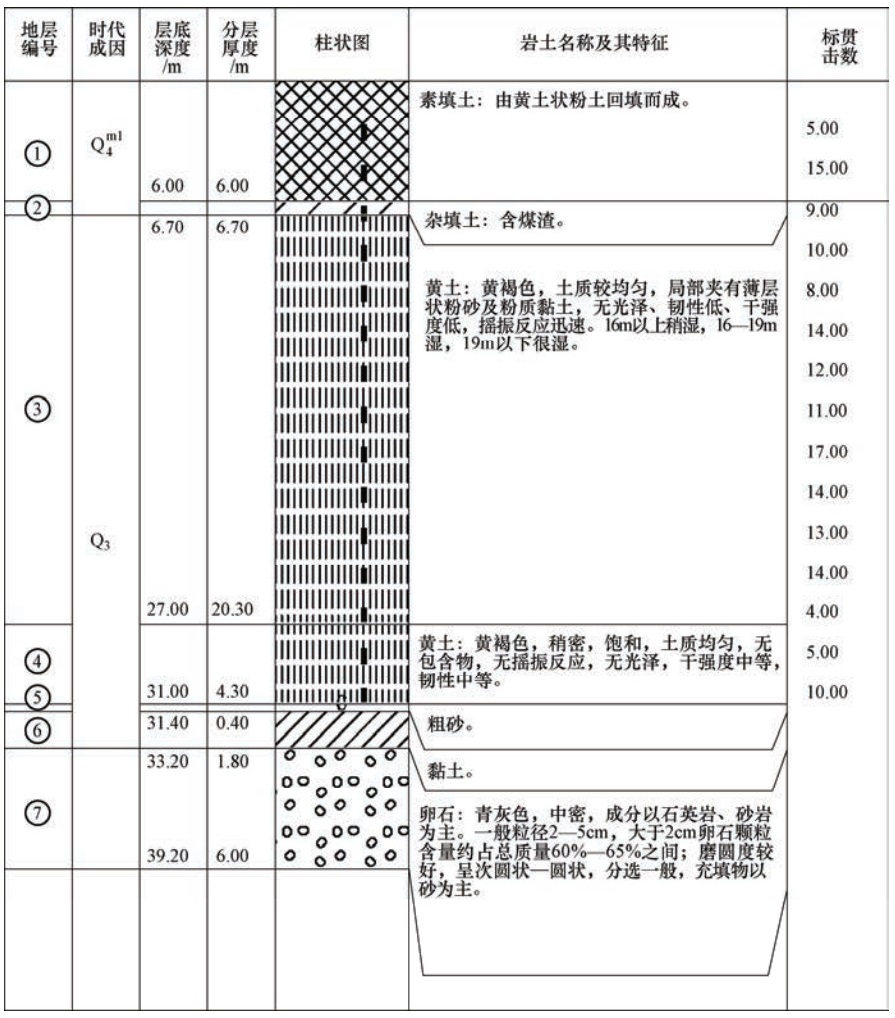
 下载:
下载:

